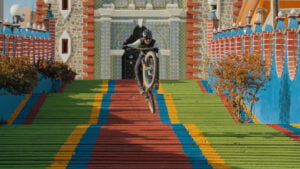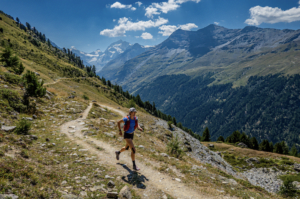In the world of extreme sports, few pursuits are as exhilarating and visually captivating as highlining, where individuals walk across thin, swaying lines suspended high above the ground. We had the privilege of sitting down with Jack Gooch, a highlining enthusiast who has taken this gravity-defying sport to new heights, quite literally. But Jack’s journey to becoming a highlining guru was far from conventional. Hailing from the picturesque Perth hills region in Western Australia, he spent his teenage years immersed in a different world of bicycles, velodrome racing, and downhill biking. However, life took an unexpected turn when a congenital heart anomaly led to a heart attack at the age of 19, followed by a devastating back injury just six weeks later. These life-altering events marked the beginning of his fitness journey as an adult. Today, we delve into Jack’s incredible transformation, his passion for slacklining, and his daring exploits on highlines that touch the skies. So, sit back and prepare to be inspired as we explore the world of highlining through the eyes of Jack Gooch.

You spent your teenage years a little different to how you live now, can you tell us a bit about yourself and how you got into slacklining?
I grew up in the Perth Hills region in WA. I had a pretty normal life. When I was younger, I rode a lot of bicycles – velodrome, BMX, criterium, downhill biking, and MTB. However, as I hit my teenage years, I became lazy and unhealthy, developing bad habits like smoking and engaging in little physical activity. A real shock came at age 19 when I suffered a heart attack caused by a congenital heart anomaly – it turned out I have 2 left coronary arteries, one slightly impinged, of which I was unaware. The next shock was a bicycle crash just 6 weeks later, resulting in a crushed L2 vertebra (30% gone) and herniated 3 spinal discs. The recovery was long and slow; four years passed before I experienced my first pain-free day, not to mention the daily anxiety after the heart attack. Both events marked the start of my fitness journey as an adult.
I got into slacklining because I’ve always loved balance activities – circus, unicycling, juggling, trail running, etc. I saw someone doing it in a local park and thought, “Awesome, I’ll buy one and teach myself.” So, in my backyard over some crumbly rocks, I learned to walk my first 15-meter line over about a month of grinding. Nowadays, I assist in teaching newcomers, and they can usually cross the same line in 1-2 sessions. After that, I watched a short film by the Flying Frenchies showcasing a massive highline across the French Alps and decided, for my next birthday, I wanted to learn how to set one up and step out on a highline. About 18 months later, I had finally made the right connections and friends with knowledge, and we set up our first highline in Perth in 2017.
How many times a week do you go slacklining nowadays roughly?
I try to highline at least once every week, twice if I can. I go to the park once a week for very casual, chill, and training sessions, and I have a small rodeo line inside my local gym that I also train on once a week.

Talking to quite a few people from the slacklining community, it seems that most slackliners come from climbing, do you have an explanation for this?
Traditionally, the sport of highlining developed in Yosemite National Park, which is a climbing Mecca. We use a lot of the same anchoring gear and principles as climbing. The crossover of gear knowledge allows climbers to make an easy transition to the sport. Additionally, we generally share the same crags as climbers, so they will often be around. Lastly, the exposure of being on a line is akin to being on a big runout on a lead climbing route. So, again, climbers have some familiarity here. These days, it’s becoming more normal for people to enter the sport without any climbing experience, but for sure, the majority of slackliners have a climbing background.
Slacklining is one thing, but you have been involved in quite a few highlining projects too. It looks incredibly dangerous but would you say it’s actually safe as you’re always clicked in? (briefly describe what highlining is)
Highlining is the act of rigging and walking a slackline between any two high points, like mountain cliffs, sea cliffs, or large trees in the forest. It has a significant visual impact and can appear quite precarious. While there is inherent risk being up in the sky, highlining is a very safe practice. All systems we use adhere to standardized rigging principles and are robust and redundant. (The primary example of redundancy is that we always use two slacklines in the system; if the main slackline were to fail, the second slackline would catch you.) Every anchor piece and every part of the rig undergoes redundancy checks by competent riggers. And yes, we are always tethered to the line with a very strong leash!
When walking on a highline, do you ever turn around if you have a dodgy feeling, or is the best way always forward once you’ve started?
Yes, sometimes it’s better to trust your gut feeling and get off to make sure the rig is okay. I’ve only had to do that once or twice. When I’m genuinely scared, I prefer to push through, and it always improves. Occasionally, there’s a strong gut feeling when you sense something might be seriously amiss, and I believe it’s crucial to listen to your body and trust your intuition from time to time.

Do you have any mind-calming tips for novices to the sport in this situation?
Exposure, and more exposure! It’s super scary at the beginning. The best remedy is repeated exposure to acquaint your body with the instability. I’d recommend seeking out a 25-30-meter highline above water to learn on. The water provides a much safer feeling than being up very high in an exposed area. Breathing is also crucial; pace and time your breathing to calm the nervous system and prevent physical and adrenal fatigue.
How long were you slacklining before you went on your first highline?
About 3 years for me! I probably would have gone sooner but I didn’t even realise highlining was a sport until I watched the flying frenchies documentary. The second thing that stopped me from going sooner was that there was literally no one highlining in Perth, so it took a while to make the right connections and build up the community.
Would you like for slacklining or highlining to become a more mass sport, maybe even being part of the Olympics at some point?
I would definitely love to see highlining become a popular sport and enter the Olympics. I am the state representative of the Australian Slackline Association for Western Australia. My role there involves negotiating and managing land access with landowners and building relationships with councils and official bodies. Alongside this, I have created and maintain the highline guidebook for WA. I hope this work will pave the way for new people to enter the sport with a lower barrier to entry and a clearer pathway on how to get started.

Do you have a bucket list highline project?
One of my career goals with highlining is to rig and cross a 1 kilometre highline. With the latest advancements in webbing technology it’s becoming more common to rig these monster lines, I would love to do that!
The other major goal I have is to continue developing and establishing crags and lines across WA which is my home.
We heard through the grapevine that you and a team of people went to complete the highest highline in WA, can you tell us a bit about this project? (how did you get the idea, how did you put the team together, logistics, how long did it take you etc)
Yes, In October last year we ventured out to the stirling ranges to tackle an ambitious highline project. We ended up rigging 2 highlines, the more impressive one is across the top of the stirling ranges ridge walk. This is the only region in WA considered to be sub-alpine, getting snow roughly once a year during winter. The ridge walk is considered one of the most difficult hikes in Australia, the trails are not maintained and there basically no maps of the area, it’s very easy to get lost walking through bush that’s above head height, very steep climbs scrambling up scree and unpredictable weather conditions. Our line was about 950m elevation above sea level which put it as WA’s highest highline at the time and we had an outstanding media response after posting some of the imagery.
The idea came about mostly from Nick Pontin who grew up in the Albany region, nearby to the stirling ranges and he had it as a project in his mind for years before proposing it to the crew. The logistics were pretty difficult, we went up 4 separate times with a crew of 10 people in total that changed between each trip, we did 2 reconnaissance trips and 2 rigging trips to complete the 2 lines. It took us about a week in total to complete everything and get down safely.

Can we expect to see some photos of this or maybe even a film?
Yes! Jeremy Shepherd @the.wandering.shepherd was our stills photographer and Alex Clapin @mediabytheuntamed was our filmographer. The imagery has already been posted on both these pages, come October Alex has produced a 10 minute film that is featuring in the vertical life film tour showcasing the epic landscapes of WA and our journey as a crew to complete the trip. Expect savage weather, epic scenery and a light-hearted fun film.
You can now STREAM online the Radical Reels 2023 program here on AdventureReelsTV.com
Follow Jack for more tips and highlining content HERE






